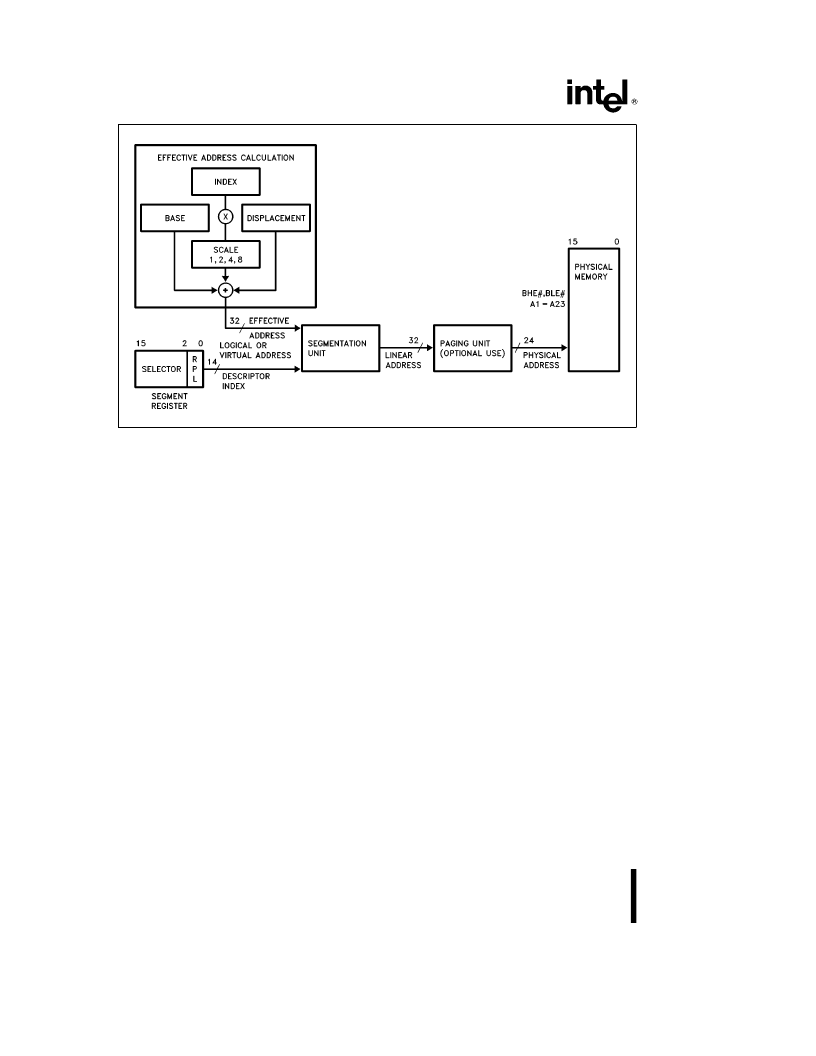- 您現(xiàn)在的位置:買賣IC網(wǎng) > PDF目錄373200 > KU386 (Intel Corp.) SX MICROPROCESSOR PDF資料下載
參數(shù)資料
| 型號: | KU386 |
| 廠商: | Intel Corp. |
| 英文描述: | SX MICROPROCESSOR |
| 中文描述: | SX微處理器 |
| 文件頁數(shù): | 12/102頁 |
| 文件大?。?/td> | 1268K |
| 代理商: | KU386 |
第1頁第2頁第3頁第4頁第5頁第6頁第7頁第8頁第9頁第10頁第11頁當(dāng)前第12頁第13頁第14頁第15頁第16頁第17頁第18頁第19頁第20頁第21頁第22頁第23頁第24頁第25頁第26頁第27頁第28頁第29頁第30頁第31頁第32頁第33頁第34頁第35頁第36頁第37頁第38頁第39頁第40頁第41頁第42頁第43頁第44頁第45頁第46頁第47頁第48頁第49頁第50頁第51頁第52頁第53頁第54頁第55頁第56頁第57頁第58頁第59頁第60頁第61頁第62頁第63頁第64頁第65頁第66頁第67頁第68頁第69頁第70頁第71頁第72頁第73頁第74頁第75頁第76頁第77頁第78頁第79頁第80頁第81頁第82頁第83頁第84頁第85頁第86頁第87頁第88頁第89頁第90頁第91頁第92頁第93頁第94頁第95頁第96頁第97頁第98頁第99頁第100頁第101頁第102頁

Intel386
TM
SX MICROPROCESSOR
240187–4
Figure 2.3. Address Translation
SEGMENT REGISTER USAGE
The main data structure used to organize memory is
the segment. On the Intel386 SX Microprocessor,
segments are variable sized blocks of linear ad-
dresses which have certain attributes associated
with them. There are two main types of segments,
code and data. The segments are of variable size
and can be as small as 1 byte or as large as 4 giga-
bytes (2
32
bits).
In order to provide compact instruction encoding
and increase processor performance, instructions
do not need to explicitly specify which segment reg-
ister is used. The segment register is automatically
chosen according to the rules of Table 2.3 (Segment
Register Selection Rules). In general, data refer-
ences use the selector contained in the DS register,
stack references use the SS register and instruction
fetches use the CS register. The contents of the In-
struction Pointer provide the offset. Special segment
override prefixes allow the explicit use of a given
segment register, and override the implicit rules list-
ed in Table 2.3. The override prefixes also allow the
use of the ES, FS and GS segment registers.
There are no restrictions regarding the overlapping
of the base addresses of any segments. Thus, all 6
segments could have the base address set to zero
and create a system with a four gigabyte linear ad-
dress space. This creates a system where the virtual
address space is the same as the linear address
space. Further details of segmentation are dis-
cussed in chapter 4
PROTECTED MODE ARCHI-
TECTURE
.
2.4 Addressing Modes
The Intel386 SX Microprocessor provides a total of 8
addressing modes for instructions to specify oper-
ands. The addressing modes are optimized to allow
the efficient execution of high level languages such
as C and FORTRAN, and they cover the vast majori-
ty of data references needed by high-level lan-
guages.
REGISTER AND IMMEDIATE MODES
Two of the addressing modes provide for instruc-
tions that operate on register or immediate oper-
ands:
Register Operand Mode:
The operand is located in
one of the 8, 16 or 32-bit general registers.
Immediate Operand Mode:
The operand is includ-
ed in the instruction as part of the opcode.
12
相關(guān)PDF資料 |
PDF描述 |
|---|---|
| KU80C186EC25 | 16-BIT HIGH-INTEGRATION EMBEDDED PROCESSORS |
| KU80C188EC16 | 16-BIT HIGH-INTEGRATION EMBEDDED PROCESSORS |
| KU80C188EC25 | 16-BIT HIGH-INTEGRATION EMBEDDED PROCESSORS |
| KU80L186EC16 | 16-BIT HIGH-INTEGRATION EMBEDDED PROCESSORS |
| KU80L186EC20 | 16-BIT HIGH-INTEGRATION EMBEDDED PROCESSORS |
相關(guān)代理商/技術(shù)參數(shù) |
參數(shù)描述 |
|---|---|
| KU-3C-110D | 制造商:M.E.C. Relays 功能描述: |
| KU-3C-120A | 制造商:M.E.C. Relays 功能描述: 制造商:Master Electronic Controls (MEC) 功能描述: |
| KU-3C-12A | 制造商:M.E.C. Relays 功能描述: |
| KU-3C-12D | 制造商:M.E.C. Relays 功能描述: |
| KU-3C-240A | 制造商:M.E.C. Relays 功能描述: |
發(fā)布緊急采購,3分鐘左右您將得到回復(fù)。